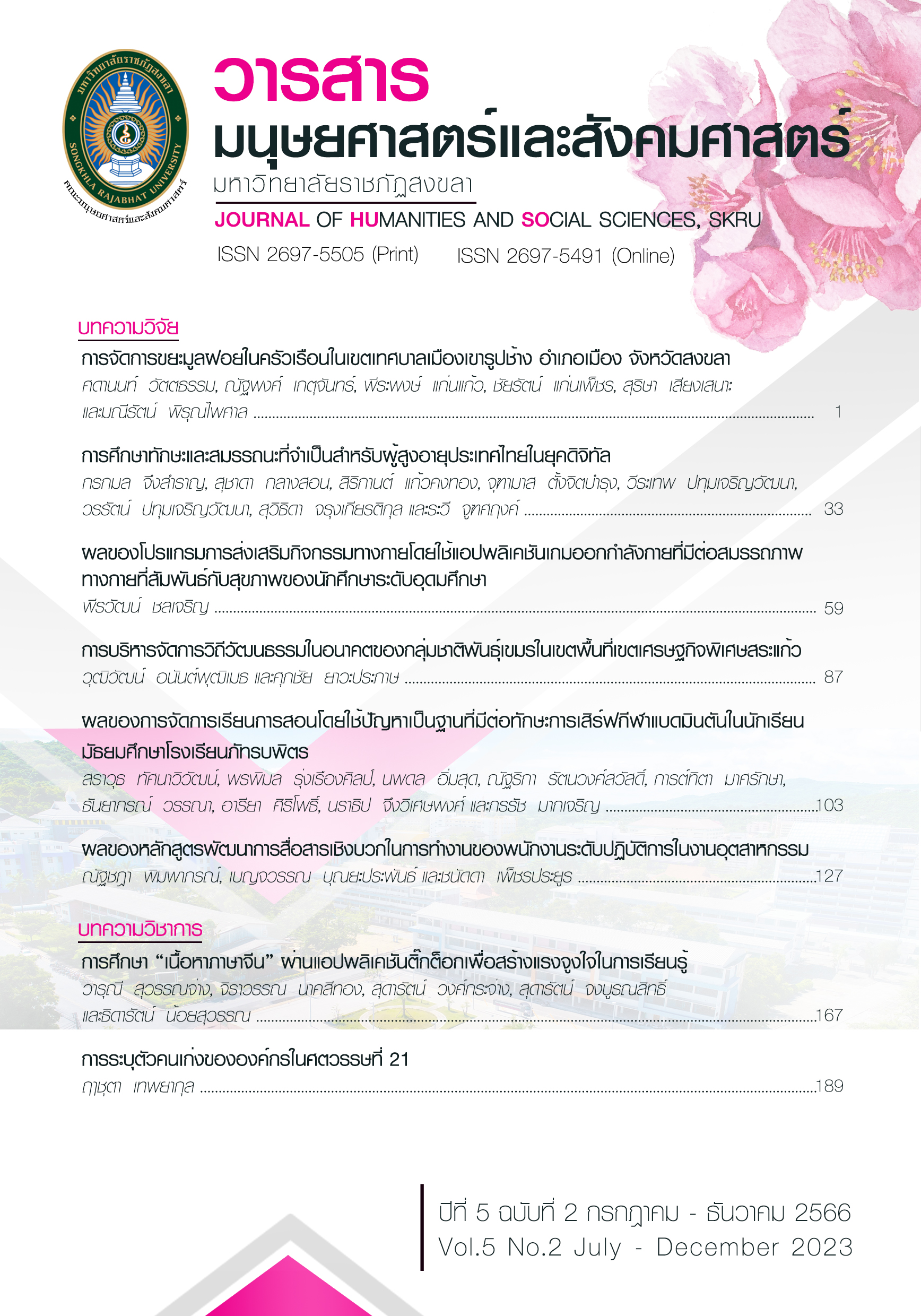THE EFFECT OF POSITIVE COMMUNICATION DEVELOPMENT COURSE AT WORK OF OPERATIONAL EMPLOYEES IN INDUSTRIAL WORK
Main Article Content
Abstract
The objectives of this research were (1) to study the meaning of positive communication in the work of operational employees in industry, (2) to create and design a course to develop positive communication in the work of operational employees in industry, and (3) to compare positive communication in the work of operational employees in industry. Before and after joining the positive communication development course at work. The sample group was operational employees in industry. The research tools were structured in-depth interviews and positive communication development course for employees. The content consistency value of the course was of not less than 0.5. The reliability of the questionnaire was of .954. Statistics used for data analysis were mean, standard deviation, and Wilcoxon Signed-Ranks Test.
Results of the research using qualitative data analysis techniques with content analysis showed that (1) Positive communication in work means the way in which the sender uses words or a creative message to the receiver to create understanding form a good relationship reduce conflict and help motivate cooperation in order to achieve the goals set together, The positive communication in work consists of 4 elements attention to the interlocutor, using effective body language, creative use of language for communication partners, and the use of horizontal communication. (2) The course for developing positive communication in the work of operational employees in industry consists of 9 times of training with 16 activities. (3) Operational employees in industry who participated in positive communication development course at work had higher post-join scores than before, statistically significant at the .01 level.
Downloads
Article Details

This work is licensed under a Creative Commons Attribution-NonCommercial-NoDerivatives 4.0 International License.
ลิขสิทธิ
References
เกษราภรณ์ งามสุวรรณฉาย, ชุติระ ระบอบ และพิษณุ วรรณกูล. (2564). การพัฒนาทักษะการสื่อสารของพนักงานบริษัทผู้ให้บริการโลจิสติกส์ขนส่งสินค้าข้ามแดนเพื่อเพิ่มประสิทธิภาพในการปฏิบัติงาน. มหาวิทยาลัยการจัดการและเทคโนโลยีอีสเทิร์น. 18(2), 14–26.
จินตนา วีระปรียากูร และเผชิญ กิจระการ. (2562). การพัฒนาโมเดลสภาพแวดล้อมการจัดการเรียนการสอนภาษาอังกฤษเพื่อการสื่อสารแบบผสมผสาน ด้วยกระบวนการเรียนรู้เชิงรุก เพื่อส่งเสริมทักษะในการสื่อสารเชิงสร้างสรรค์ และทักษะการทำงานร่วมกันของนักศึกษาระดับปริญญาตรี. ราชพฤกษ์. 17(2), 43–55.
ฉัตรศิริ ปิยะมลสิทธิ์. (2548). ความเที่ยงตรง. เอกสารประกอบการสอนเรื่องทฤษฎีการวัดและการทดสอบ. คณะศึกษาศาสตร์ มหาวิทยาลัยทักษิณ.
ช่อทิพย์ บรมธนรัตน์. (2557). การสื่อสารในองค์กรสาธารณสุข. สืบค้นเมื่อ 23 มีนาคม 2559, จาก http://www.stou.ac.th/Schools/Shs/booklet/book574/PbHealth574.pdf
นพวรรณ โลนุช และกล้าหาญ ณ น่าน. (2564). บรรยากาศองค์การและกระบวนการสื่อสารที่ส่งผลต่อประสิทธิภาพการสื่อสารภายในองค์การ ของพนักงานมหาวิทยาลัยสายสนับสนุน มหาวิทยาลัยเทคโนโลยีราชมงคลธัญบุรี. การตลาดและการจัดการมหาวิทยาลัยเทคโนโลยีราชมงคลธัญบุรี. 9(2), 82–96.
นภวรรณ ตันติเวชกุล. (2542). การวิเคราะห์อิทธิพลของภาพยนตร์โฆษณาทางโทรทัศน์ ตามแนวทฤษฎีการอบรมบ่มนิสัยทางวัฒนธรรมต่อเยาวชนในสถานศึกษา. วิทยานิพนธ์ปริญญาดุษฎีบัณฑิต, จุฬาลงกรณ์มหาวิทยาลัย.
นวลฉวี ประเสริฐสุข. (2558). สื่ อสารอย่างสร้างสรรค์เพื่อสร้างสุขในครอบครัว. Veridian E –Journal,Silpakorn University ฉบับภาษาไทย สาขามนุษยศาสตร์ สังคมศาสตร์ และศิลปะ. 8(2), 737-747.
ปรมิษฏ์ ปุรณาคม. (2561). การศึกษาความพึงพอใจของพนักงานที่มีต่อการสื่อสารภายในองค์กรกรณีศึกษาของธุรกิจอุตสาหกรรมยาสูบแห่งหนึ่ง. สารนิพนธ์หลักสูตรปริญญาการจัดการมหาบัณฑิตวิทยาลัยการจัดการ คณะบัณฑิตวิทยาลัย,มหาวิทยาลัยมหิดล. นครปฐม: มหาวิทยาลัยมหิดล.
พงษ์ศักดิ์ ทองพันชั่ง. (2564). ข้อเสนอกลยุทธ์การสื่อสารสร้างสุขในการทำงานของบุคลากรกรณีมหาวิทยาลัยราชภัฏภูมิภาคอีสานใต้. มหาวิทยาลัยราชภัฏศรีสะเกษ. 15(2), 109-121.
มารุฒ พัฒผล. (2558). บทที่ 6 การสื่อสารเชิงบวก. สืบค้นเมื่อ 10 มกราคม 2566, จาก https://dspace.bru.ac.th/xmlui/bitstream/handle/123456789/7761/%E0
ประสงค์ เขื่อนสุวงศ์. (2560). การพัฒนาภาวะผู้นำของผู้บริหารสถานศึกษา. วไลยอลงกรณ์ปริทัศน์ (มนุษยศาสตร์และสังคมศาสตร์). 7(3), 13-24.
ปุณญฬินัล กริสกรี. (2559). การพัฒนาคู่มือส่งเสริมพัฒนาการเด็กสำหรับครูปฐมวัยในศูนย์พัฒนาเด็กเล็กจังหวัดนครศรีธรรมราช. นาคบุตรปริทรรศน์. 7(1), 11-19.
รัชนก เชื้อแพทย์. (2563). รูปแบบการสื่อสารภายในองค์กรที่มีประสิทธิภาพของบริษัทในนิคมอุตสาหกรรมโรจนะ จังหวัดพระนครศรีอยุธยา. บริหารธุรกิจมหาบัณฑิต สาขาวิชาบริหารธุรกิจ, มหาวิทยาลัยราชภัฏพระนครศรีอยุธยา. พระนครศรีอยุธยา: มหาวิทยาลัยราชภัฏพระนครศรีอยุธยา.
เสนาะ ติเยาว์. (2537). การสื่อสารในองค์การ. กรุงเทพฯ: มหาวิทยาลัยธรรมศาสตร์.
หริรักษ์ แก้วกับทอง. (2560). บทที่ 6 การสื่อสารเชิงบวก. สืบค้นเมื่อ 10 มกราคม 2566, จาก https://dspace.bru.ac.th/xmlui/bitstream/handle/123456789/7761/%E0
Baracz, S., & Buisman-Pijlman, F. (2017). How childhood trauma changes our hormones and thus our mental health into adulthood. Retrieved from The Conversation: https://theconversation.com/how-childhood-trauma-changes-ourhormones-and-thus-our-mental-health-into-adulthood-84689
Berlo, K. (1960). The Process of Communication. New York: Hoit, Rinehart and Winston.
Cronbach, L. J. (1949). Essentials of psychological testing. n.p.
Gordon, T. (1975). P.E.T. Parent Effectiveness Training: The Tested New Way to Raise Responsible Children. New York: New American Library.
Guilford, J. P. (1967). The nature of human intelligence: McGraw-Hill.
Lacobucci, D., & Duhachek, A. (2003). Advancing Alpha: Measuring Reliability with Confidence. Journal of Consumer. 13(4), 478-487.
Lambie, J. (2018). Should you hide negative emotions from children. Retrieved from The Conversation: https://theconversation.com/
should-you-hide-negativeemotions-from-children-104710


